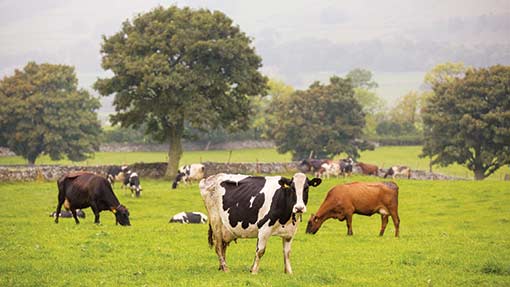Grazing strategy to help cows make most of grass in wet weather

Dairy farmers looking to make the most from early-grazed grass this spring should consider “on-off grazing” to maximise intakes and avoid long-term field damage because of the wet conditions.
Piers Badnell, extension officer for DairyCo, believes grazing cows intensively for two three-hour blocks and bringing cows inside in between is the only option following the wet start to the year.
Failure to address grazing management inline with the conditions could reduce grass yield potential for the rest of the season.
“Pasture damage happens when cows are filled up and walking around, so by grazing hard, you get less damage,” he says.
See also Grazing top tips
“Look around the farm and see where you can get out. It’s not going to be possible on low-lying farms, but anyone with higher ground, who has good tracks and grazing infrastructure, should consider on-off grazing – it’s the only way to go this year.”
Irish research has shown cows can achieve 90% of their required dry matter intakes by grazing in two blocks.
Phil Cooper, of the Farm Consultancy Group, says by grazing between 8-11am and 5-8pm you are making the most of the periods of the day when a cow’s grazing intakes are at their highest. However, the key is to let them out to grass with an edge on appetite.
“When you bring cows back in you want to avoid buffer feeding where possible or time feeding so there is a break before you turn them out again,” he says.
Mr Cooper says spring calvers yielding about 5,000 litres and with target dry matter intakes of 18-19kg/day should be able to achieve 90% of intakes from grass, with the rest topped up in the parlour.
This will depend on weather and a judgement call will have to be made based on grass quality. Higher yielders may require buffer feeding.
Dorset farmer Andy Roberts has practiced on-off grazing with his herd of 250 5,800-litre spring calving Jersey and Friesian cross cows for a number of years.
Although his heavy clay farm at St Margaret Marsh, Shaftesbury, is too wet at present to graze, he plans on using on-off grazing in March if ground conditions allow.
“During on-off grazing, cows go out after milking and graze from 8am to 11.30am. They’re then brought back in to cubicles, but they won’t receive silage. They then go back out after afternoon milking from 5.50pm to about 8.30pm.”
Cows get cake in the parlour and may receive some silage in the afternoon, but Mr Roberts emphasises the need for cows to go out with an edge on appetite.
“It’s amazing how little silage they need. The main thing is to ensure silage tops up the grass, not the other way around,” he says.
When grazing, Mr Roberts also stresses the importance of good infrastructure and the need to back fence so cows are prevented from damaging the whole field.
He also believes targeting the highest covers is important to minimise sward damage and likes to go into fields at 3,000kg/ha of DM or over.
Mr Cooper agrees: “There may be some fields of 3,000kg/ha DM on the grazing platform so target these covers first. I’d say covers have got to be more than 2,000kg/ha DM to do on-off grazing.”
Mr Badnell also says achieving residuals of 1,500kg/ha DM in the first two grazing rounds is essential to ensure pasture is set up for the year ahead.
